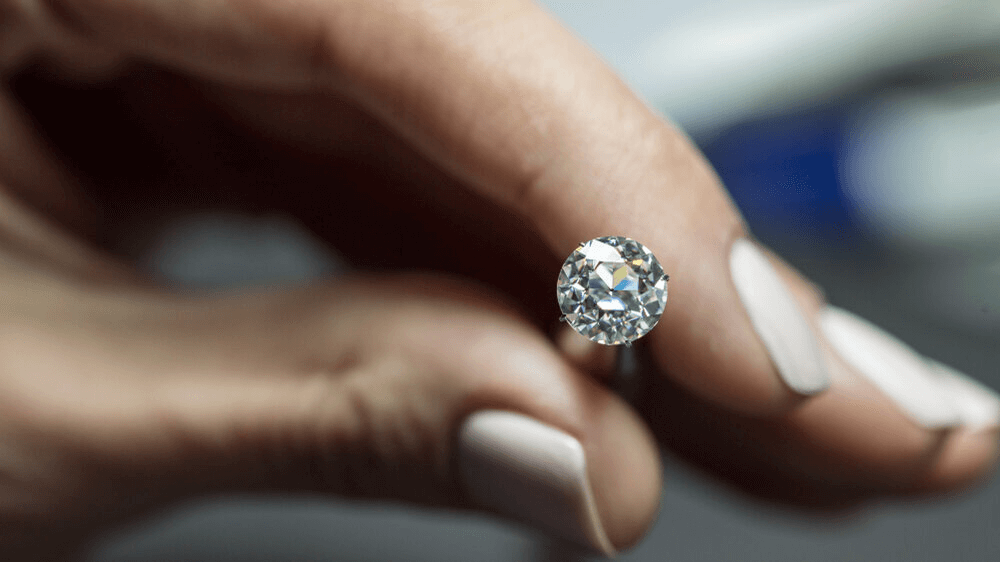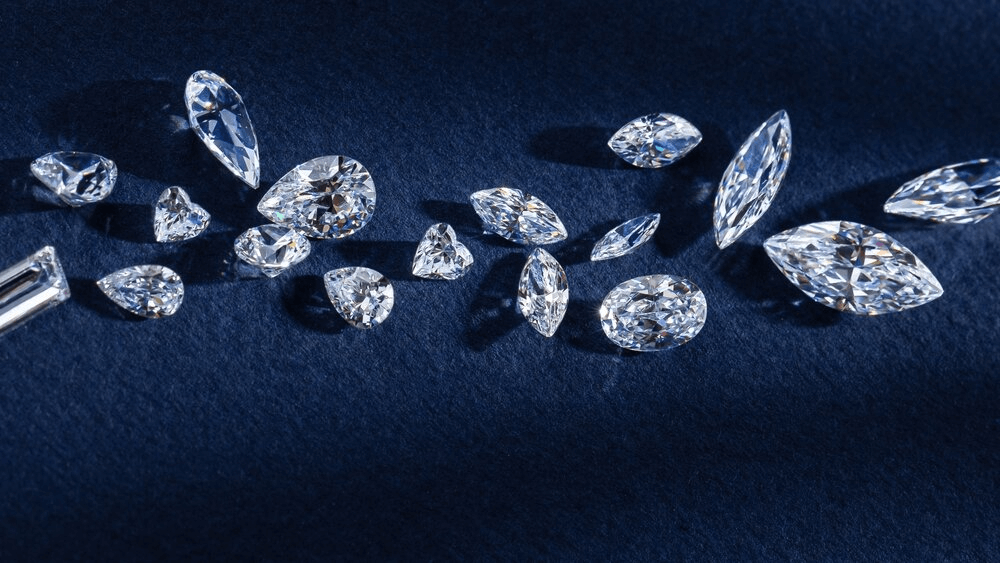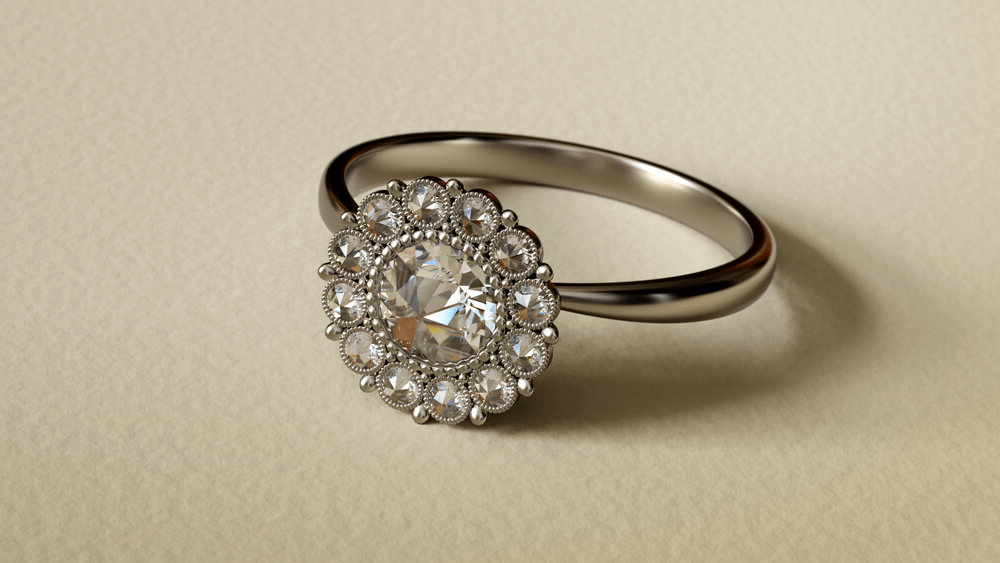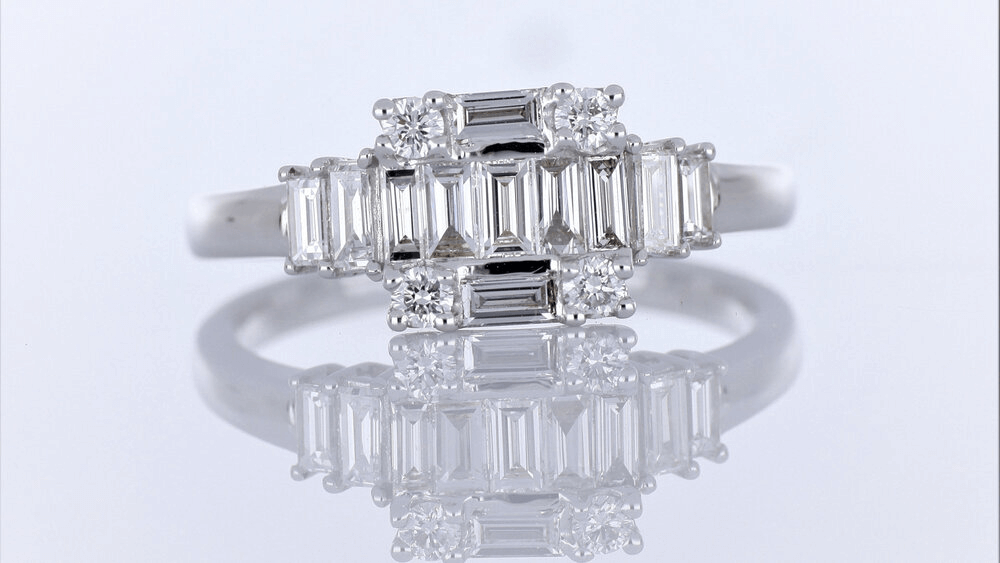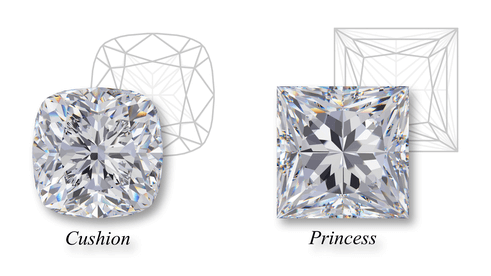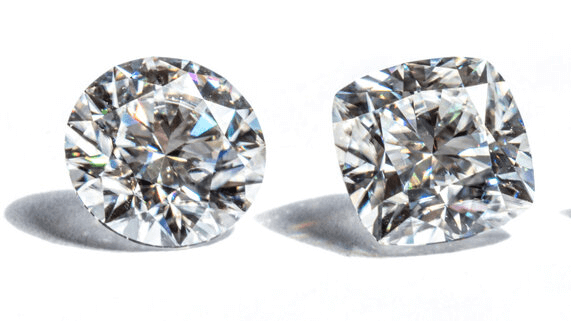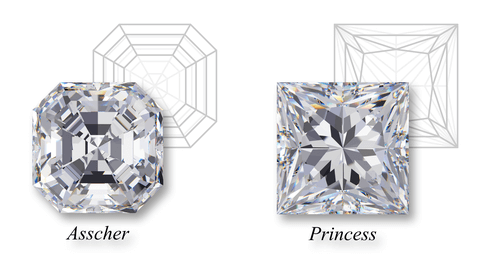The Diamond Face-Off: Radiant Cut or Cushion Cut?

By Gary A.

Edited by Olivia H.
Published Oct 9, 2021
Edited on Mar 31, 2025
When it comes to choosing between a radiant vs cushion cut diamond, how do you know which one perfectly captures your style—are you drawn to the bold brilliance or the romantic fire?

- 8 Quick Tips for Choosing Between Radiant Cut and Cushion Cut
- Introduction
- Understanding the Differences Between the Radiant Cut and the Cushion Cut
- Size and Perception: What Looks Bigger and Why
- Light Performance (Sparkle): Radiant vs Cushion
- Cost Analysis: Radiant vs Cushion Cut Diamonds
- Durability: Radiant vs Cushion, Which is Stronger?
- Our Expert Take
- 10 FAQs
Before we dive deeper into the specifics, here are some practical tips to help guide your decision-making process:
8 Quick Tips for Choosing Between Radiant Cut and Cushion Cut
When selecting a diamond engagement ring, especially when debating between a radiant cut and a cushion cut, there are several practical aspects to consider. Here are the key tips to guide you through this important decision:
- Tip 1: Understand the Unique Characteristics of Each Cut: Radiant Cut: Known for its brilliance and crisp, sharp lines, a radiant cut diamond combines the elegance of emerald-cut with the brilliance of round diamonds. It often appears more elongated and is ideal for someone who appreciates a contemporary look with a high level of sparkle.
- Tip 2: Cushion Cut: Cushion cut diamonds offer a softer, more romantic look with rounded corners and larger facets. They are renowned for their fire and vintage charm, making them suitable for someone who prefers a classic and timeless style.
- Tip 3: Evaluate the Diamond’s Proportions and Symmetry: For Radiant Cut: Look for a well-proportioned diamond that maximizes its surface area for greater brilliance. A length-to-width ratio between 1.00 and 1.10 is often ideal for a balanced look. For Cushion Cut: Ideal cushion cuts often have a length-to-width ratio between 1.00 and 1.05, maintaining the diamond’s symmetry and balanced appearance. Observe the diamond from different angles to ensure its facets align symmetrically.
- Tip 4: Assess the Setting Style Compatibility: Consider the setting style that complements each cut. A radiant cut diamond works well with modern and sleek settings, such as a solitaire or a geometric halo design. On the other hand, cushion cut diamonds are versatile and pair beautifully with vintage-inspired settings, as well as classic halo designs.
- Tip 5: Compare Sparkle and Brilliance: While both cuts are brilliant, they exhibit different types of sparkle. Radiant cuts display a more intense, sharp brilliance due to their facet pattern, while cushion cuts offer a softer, more dispersed sparkle. Viewing the diamonds in various lighting conditions will help you appreciate their unique sparkle characteristics.
- Tip 6: Factor in Size Appearance and Finger Coverage: Radiant cut diamonds often appear larger and more elongated, providing an elongating effect on the finger. Cushion cuts, with their rounded edges, might seem smaller in comparison but offer substantial finger coverage. Consider the visual impact on the wearer’s hand when making your choice.
- Tip 7: Be Mindful of Color and Clarity Preferences: Since radiant cuts can mask color and inclusions better due to their facet arrangement, you might opt for a slightly lower color and clarity grade without compromising the diamond’s appearance. Cushion cuts, with their larger facets, may require a higher clarity grade to ensure inclusions are not visible.
- Tip 8: Pay Attention to the Diamond’s Overall Appeal: Ultimately, the choice between a radiant cut and a cushion cut should align with the personal style and preference of the wearer. Observe the diamond’s overall appeal, including its brilliance, fire, shape, and how it complements the wearer’s hand and personal style.
Now that you’ve got these practical tips, use Jeweler AI below to find the perfect engagement ring that suits your style and budget:
Introduction
When it comes to lavish and luxurious diamond cuts, two of the first names that spring to mind are the Radiant and the Cushion. Both featuring pretty similar facet patterns, particularly high levels of fire, and versatile, timeless shapes, choosing between the Radiant and Cushion is not easy – especially if you’re still struggling to work out the differences between them.
It’s certainly understandable – both shapes are very similar – but there’s a few key points you should know before you make your choice.
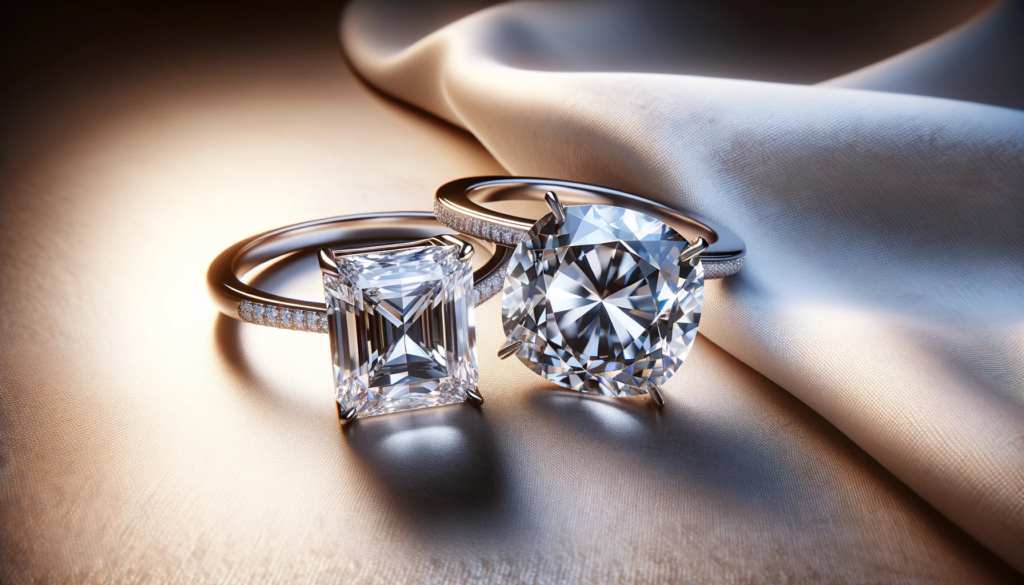
Understanding the Differences Between the Radiant Cut and the Cushion Cut
For starters, the Cushion cut stems back around two hundred years, while the Radiant is considerably younger, having been developed less than fifty years ago, in the late 1970s.
The most noticeable difference between this two cuts lies in their silhouettes. While the Radiant features beveled corners (creating an irregular octagon shape, rather than a rectangle), the Cushion has those characteristically smooth, rounded corners that lend it its name in the first place.
While this may seem like a pretty minor difference, it means that the two shapes give off entirely different vibes. The Cushion looks plush and sumptuous, while the Radiant looks a little more refined and geometric – a silhouette very similar to the Emerald, while still preserving the Brilliant facet pattern so many of us want.
While both cuts are available with square and rectangular dimensions, it is much more common for the Radiant to be rectangular. The Cushion, on the other hand, is much more popular with square dimensions – though both simply fall down to personal preference.

Size and Perception: What Looks Bigger and Why
The Radiant will typically look longer than a rectangular Cushion. That same Cushion cut diamond, however, will look wider than the Radiant.
As you can see, there’s no simple answer to this question. The difference in weight distribution between a properly proportioned Radiant and a properly proportioned Cushion is such that each cut will look bigger (and smaller) in its own way.
If you like the elegant, elongating effect a rectangular shape has on the finger, then Radiant might just clinch the deal here. If you would prefer the rounder, plusher look created by rounder shapes like the Oval when they’re worn on the finger, however, then you’ll know the Cushion is the one for you.
Light Performance (Sparkle): Radiant vs Cushion
In two diamonds of the same cut quality and size, you can expect the Radiant to produce more brilliance, while the Cushion will produce more fire.
This is one factor that can help shoppers to make up their minds more than any other, since most tend to have a preference for maximizing fire or brilliance.
One of the things that makes the Cushion such a desirable cut is its ability to produce a lot more fire than many other cuts, which creates an incredible display of colorful light across the surface of the ring as the wearer moves their hand under a light source.
At the same time, a major selling point for the Radiant cut is the very high degree of brilliance it creates, meaning a dazzlingly bright show of white light.
Again, there’s no straightforward answer here; it comes down to personal preference, and what feels right for your bride-to-be. Both diamonds will offer plenty of sparkle, and you’re only likely to notice the most significant difference if you’re comparing the two side-by-side.
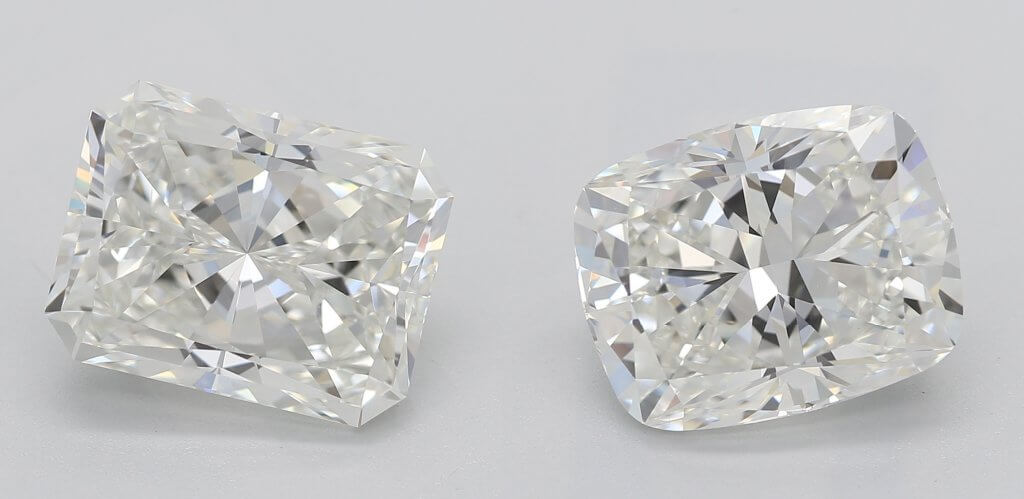
Cost Analysis: Radiant vs Cushion Cut Diamonds
Cushion and Radiant cuts tend to be very similar in price, since both enable the diamond cutter to preserve a lot of the original rough stone, and both enjoy a similar level of popularity.
What’s more, both are considerably more affordable than the Round cut, meaning that you may be able to consider opting for a higher carat weight without changing your price point. Both shapes also offer the opportunity to put a slightly more original spin on the traditional engagement ring designs.
Durability: Radiant vs Cushion, Which is Stronger?
Both cuts are highly durable, thanks to their smoother corners.
This is one thing that helps in the debate over the Radiant vs the Princess cut – the fact that, thanks to its beveled corners, the Radiant is a little less vulnerable to chipping or breaking, particularly when it is held in place by prongs positioned at each corner.
The Cushion enjoys a similar level of durability, since, rather than featuring any sharp (and vulnerable) points, its edges and corners are smooth and gently rounded. This reduces the risk of high pressure – whether from an accidental knock, or from the ring setting itself – causing surface damage to the diamond.
So, once again, there really isn’t much discrepancy between the two shapes here.
Our Expert Take
If you’re looking for a more subtle twist on the classic Round, then we’d recommend the Cushion. If, however, you’re all about the brilliance – combined with a little geometric-elegance – then go for the Radiant.
In case it wasn’t clear already, there really is no clear winner between these two incredible cuts. Their differences are clear to see, but none of these differences brings one out on top of the other.
Yes, the Radiant offers more brilliance…but Cushion offers more fire. Yes, the rectangular Cushion looks wider on the finger…but the Radiant looks longer.
While, right now, it might seem like you’re no clearer on which shape you want to go for, you can take this as a blessing. With no significant differences in cost or durability, size, or sparkle, you’re free to explore both cuts further until you hit upon a diamond you just can’t say no to.
You can browse our full range of Cushion cut diamonds and Radiant cut diamonds online, and see which one calls to you more than the other.
10 FAQs
- Q: What is the main difference between a radiant cut and a cushion cut diamond?
A: The main difference lies in their shapes and facet patterns. Radiant cut diamonds have a more angular, crisp appearance with intense brilliance, while cushion cut diamonds offer a softer look with rounded corners and a romantic, vintage appeal. - Q: Which diamond cut looks larger, radiant or cushion?
A: Radiant cut diamonds often appear larger and more elongated, giving an elongating effect on the finger. Cushion cuts, while offering substantial finger coverage, may seem slightly smaller due to their rounded edges. - Q: Do radiant cut diamonds sparkle more than cushion cuts?
A: Yes, typically. Radiant cut diamonds are known for their sharp, intense brilliance, whereas cushion cuts provide a softer, more dispersed sparkle due to their larger facets. - Q: Are cushion cut diamonds more expensive than radiant cut diamonds?
A: The price can vary depending on several factors like carat, color, and clarity. However, generally, there’s no significant price difference purely based on the cut. - Q: Is a radiant cut diamond more durable than a cushion cut?
A: Both cuts have good durability. However, the radiant cut, with its beveled edges, may offer slightly better protection against chipping compared to the cushion cut’s softer, rounded corners. - Q: Which diamond cut is better for vintage-style settings, radiant or cushion?
A: Cushion cut diamonds are typically better suited for vintage-style settings due to their classic, timeless appearance and softer edges. - Q: Can I choose a lower color grade for radiant cut diamonds without affecting its appearance?
A: Yes, radiant cut diamonds can mask color better than some other cuts. You might opt for a slightly lower color grade without significantly impacting the diamond’s appearance. - Q: How do I decide between a radiant cut and a cushion cut diamond?
A: The decision should be based on personal preference, style, and how the diamond complements the wearer’s hand. Consider factors like shape, brilliance, size appearance, and overall aesthetic appeal. - Q: Are cushion cut diamonds better for fire?
A: Yes, cushion cut diamonds are renowned for their fire (colorful light reflections), giving them a unique and captivating appearance. - Q: Which cut is more popular for engagement rings, radiant or cushion?
A: Both cuts are popular, but it often comes down to personal preference. Cushion cuts are favored for their vintage charm, while radiant cuts are preferred for their modern and vibrant brilliance.
Discover your perfect diamond with Jeweler AI. Dive into the radiant vs cushion cut journey and find your dream engagement ring!
FOLLOW-UP GUIDE SERIES

